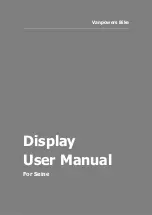
I N S T A L L A T I O N I N S T R U C T I O N S B Y O S 1 S L I D E
11
BYOS-IM Rev. 08/15 (SBK-BYOS INSTAL)
STEP SIX: Excavate the holes.
Pier holes for the flume anchor supports (Straight, 15° and 30°) should be a minimum of
12” long, 24” wide and 24” deep, or minimum 18” diameter tube.
The hole for the entry section anchor support should be a minimum of 12” long, 24” wide and
24” deep, or minimum 18” tube.
Fig. 14
24”
2
4
”
12”
24”
2
4
”
12”
ENTRY SUPPORT
24” x 24” x 12”
OR
18” Tube at 24” Depth
FLUME SUPPORTS
24” x 24” x 12”
OR
18” Tube at 24” Depth
STEP SEVEN: Reset the BYOS in position.
Ensure sufficient blocking material is on hand, then utilizing sufficient manpower; lift the
assembled slide back into its correct horizontal and vertical position and block in place.
At this point, the anchor supports should be directly over, centered and within the holes for
the piers or tubes, adjust hole location as necessary at this time. The top rebar cross member
will be approximately 4” below final concrete grade for maximum anchor embedment depth.
Minimum anchor embedment depth will have the middle rebar cross member approximately
4” below final concrete grade. (See Fig. 13) NOTE: It is essential that the vertical portions
of the anchors are plumb.
Anchor supports shall be bonded. Refer to your local building/electrical code requirements.
With the exception of the exit section landing plate (Fig. 1), make sure that a minimum 3 inch
clearance is maintained between any portion of the underside of the slide (including the
flanges) and the substrate. Based on the slider’s weight and velocity the slide can move
slightly both vertically and horizontally. If the slide rubs upon the substrate due to this motion
a wear spot and/or leak can develop.
WARNING
The above specified sizes for the concrete piers represent a minimum
and should be increased due to local weather, soil conditions, frost
line and/or local building codes. Anchor supports shall be bonded.
Refer to your local building/electrical code requirements.






































